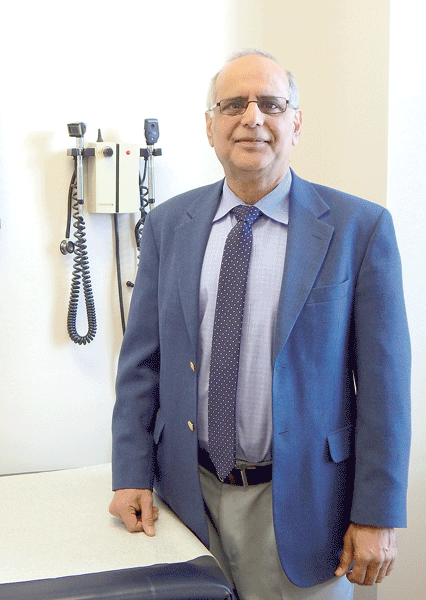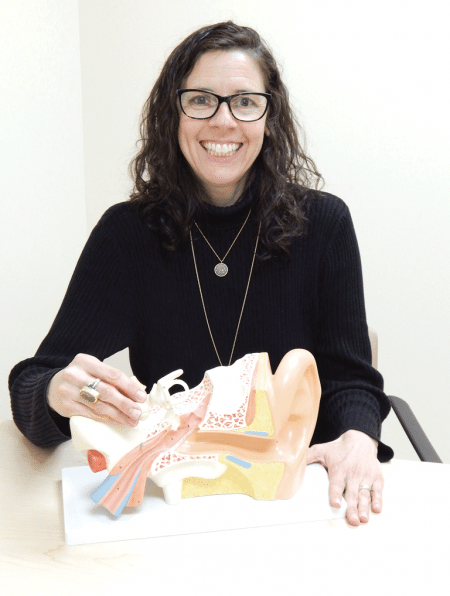Dizziness Is Often Caused by Treatable Inner-ear Malfunction
A Sense of Motion

Dr. M. Zubair Kareem says BPPV can be managed, but it is a permanent condition, and symptoms can reoccur at any time.
Some 90 million Americans will experience a sudden onset of dizziness at least once, and about 50% of those may have a condition called benign paroxysmal positional vertigo. While it’s a permanent malfunction, symptoms can be treated and managed, which is why doctors say it’s important to educate patients about the condition.
About four years ago, Jeanne Tardit got up one night and suddenly became so dizzy, she couldn’t make it to the bathroom.
“It was really scary. Everything was spinning, and I felt as if I had no control over my body,” the 86-year-old recalled. “It was something I couldn’t live with.”
Tardit numbers among an estimated 90 million Americans who will experience dizziness at least once in their lifetime. It can be frightening, and the causes can vary, so it’s important to get an accurate diagnosis.
About 50% of people, including Tardit, who experience a sudden onset of dizziness have a condition called benign paroxysmal positional vertigo, referred to as BPPV or BPV.
Dr. M. Zubair Kareem, vascular neurologist and medical director of Holyoke Medical Center’s award-winning stroke program, said the symptoms can be treated and managed, but once BPPV occurs, it can return, because it is a permanent mechanical malfunction of a part of the internal ear.
It is diagnosed by taking a good history and examining the patient; tests including a CT scan or MRI of the brain are not required. BVVP is not life-threatening or something that can be resolved with surgery or medication. However, many patients get quite nervous when an attack occurs, and sometimes require an anti-anxiety medicine at least for a short period of time.
“It’s important to educate people about what BPPV is and how it can be managed,” said Kareem, adding that, although most people associate only hearing with the ear, the organ also serves as sensor for the coordination system of the body. Since the head weighs 10 to15 pounds, people could fall forward due to the change in the center of gravity when the head bends forward, and the brain makes appropriate adjustments, which include causing the back of the neck muscles to stiffen. The inner ear is part of the body’s balance system and helps with that adjustment.
BPPV results in a false sense of motion, or vertigo, due to inaccurate signals sent to the brain, which result in dizziness or spinning that can be accompanied by nausea, loss of balance, and blurry vision due to rapid jerking movement of the eyes.
It does not make a person confused or cause any paralysis, disorientation, pain, or speech or language problem, but some patients experience significant anxiety, which can be disabling. Symptoms may vary in each person, and they are typically brought on by changing the position of the body or head position, and often occur when a person looks up, bends down, rolls over, or gets out of bed.
About 2% to 4% of people experience BPPV in their lifetime, and the Mayo Clinic reports it is the cause of approximately 50% of dizziness in the elderly population.

Caitlin Eckhoff demonstrates one of four sequential head positions used in the Epley maneuver, which was designed to reduce vertigo.
Although it can be extremely uncomfortable and disrupt a person’s work and social life, the problem is usually treatable and can be helped with specific, easy-to-learn exercises that patients do whenever a dizzy spell begins. Kareem, along with other doctors and physical therapists trained in vestibular rehabilation therapy, often teach their patients to do these exercises.
In addition, Kareem employs something called the Epley maneuver, which was developed by and named after Dr. John Epley in 1980 and consists of a series of carefully orchestrated head movements. However, for the Epley maneuver to be successful, it is important to have a precise diagnosis and know the exact location of the malfunction.
Kareem does not recommend this maneuver to patients of advanced age or with neck arthritis. Patients unable to do the day-to-day exercises themselves may benefit from sessions with a therapist trained to administer vestibular therapy and the Epley maneuver, which can help keep vertigo from reoccurring or at least minimize the symptoms.
Mechanical Problem
Kareem says understanding BPPV involves a brief lesson in physics, and he frequently provides one to his patients using a detailed diagram.
“Basically, we have sensors in each ear that can detect our head’s movement or position,” he explained. “It’s important for the brain to know where the head is in space.”
Each ear has three sensors in the shape of tiny, semicircular canals that are filled with a jelly-like substance. One end of each tube is dilated, and its floor is lined with tiny hair cells topped by thousands of minuscule calcium carbonate crystals that are suspended in the gel, like a cloud hovering over them. When a person moves his head to the side, the weight of the crystals creates a ripple in the jelly, which causes the hair cells to move and initiates nerve impulses that are passed along the vestibular nerve to the brain to tell it the head is moving. When the brain receives this signal, it sends commands to the eyes, muscles, and the rest of the body that allow the person to maintain balance.
The system works well when people are young, unless there is a trauma to the head, but once people reach age 50, a significant number develop a problem because some of the tiny crystals break off, become loose, and settle on the floor of one of the ear canals. If that happens and the person moves their head in a certain way, the floating crystals send a false signal to the brain, which it reads as motion even though there is none. Normal signals transmitted by the moving hair follicles are subtle, but Kareem says signals from loose crystals are very strong, and the result can be a sudden onset of severe dizziness.
“It usually happens when a person gets up in the middle of the night or upon waking,” he noted, adding that BPPV typically occurs in one canal of either ear, although in some cases it can occur in both ears.
The brain is able to counter the false signal within seconds or a minute, but the vertigo, which can be severe enough to make the person feel like they are about to fall, can cause acute anxiety that can continue long after the spinning feeling stops.
Obtaining an accurate diagnosis is critical because dizziness can be caused by a number of other things. Kareem says a diagnosis of BPPV involves taking the patient’s history and administering a test called the Dix-Hallpike maneuver, which involves moving the head in a position that causes vertigo. This test can help localize the problem, but it may not be positive in every patient with BPPV.
Although no one wants to be diagnosed with a condition that can’t be cured, the good news is that the exercise, combined with the Epley maneuver, can move the loose particles into a part of the ear where they stop causing symptoms, which resolves the problem, at least temporarily, for about 90% of people.
“Once people understand the problem and know that it is not a serious, life-threatening illness, they feel comfortable managing it. With the daily exercise regimen, they feel significantly better,” said Kareem.
Tardif’s physician sent her to Attain Therapy and Fitness in Wilbraham, where she received vestibular rehabilitation. Her vertigo went away after a few sessions, and when she had another dizzy spell 18 months ago, additional treatments resolved the problem again.
Quality of Life
Lisa Blain, a certified vestibular therapist at Weldon Rehabilitation Hospital in Springfield, says many people suffer with BPPV for years because they don’t know it can be remedied.

Lisa Blain says tiny floating particles in the ear canal can lead to sudden bouts of dizziness when their motion is misinterpreted by the brain.
“The people I see have often been treated with medication or tried other things that didn’t work, and restrict their activity level because they fear moving too much will cause them to become dizzy,” she told BusinessWest.
“BPPV can be aggravating, irritating, and frightening, and a lot of people are unaware there is a treatment for it that works, but it’s important to have it correctly diagnosed,” she continued, mirroring Kareem’s statement and adding that different types of vestibular rehabilitation can be used for vertigo problems that result from concussions, stroke, or following long periods of immobilization.
She explained that the vestibular system, which is responsible for maintaining balance, consists of three parts: the central nervous system, the inner ear, and vision, which all need to communicate and work together seamlessly.
Blain advises people being treated for BPPV to bring someone with them and not plan on returning to work after a treatment because the Epley maneuver is designed to bring on dizziness, and the person may feel off balance after a session, even though the induced vertigo quickly passes. “It works well, but it can be uncomfortable in the short term,” she noted.
Caitlin Eckhoff, a physical therapist from Attain Therapy and Fitness who treated Tardif and specializes in vestibular rehabilitation, agrees, and says people often become anxious about the treatment.
She said it’s critically important for the therapist to know which ear and which canal is affected. “But 80% to 90% of patients have their symptoms resolved within two to six visits.”
Researchers do not know what causes the crystals in the ear to break off, and it can be difficult for people with BPPV to pinpoint what movements cause the onset of dizziness.
“For some, just going to the grocery store and moving their head around to find something on a shelf can cause a problem,” Eckhoff said, adding that doing exercises at home speeds the recovery process. “It’s a difficult issue for people, and a lot of people think they have to live with it. But it’s very rewarding to treat, as it’s the closest to an instant fix that I can offer someone.”
Indeed, in a day and age where people want problems resolved as quickly as possible, exercises and vestibular therapy can seemingly work small miracles.





